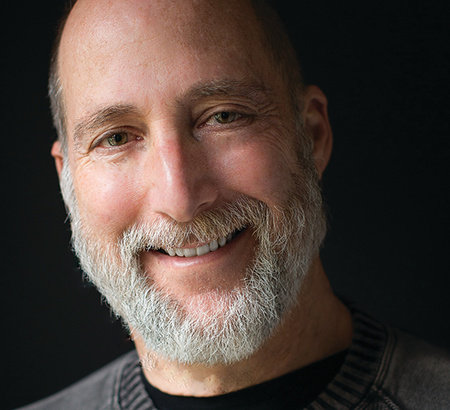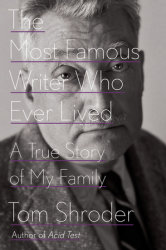The 1956 Pulitzer Prize for fiction went to the beloved American classic Andersonville by renowned novelist MacKinlay Kantor.
Of course, you — the educated elite — have already read and re-read the 768-page classic on the lives and deaths inside that infamous POW camp…
What’s that? You’re unfamiliar with the door-stopper of a Civil War story, recently re-released in a 60th-anniversary edition? Fear not dear reader, you’re not out of the literary loop.
Journalist Tom Shroder had gone through most of his life without reading his grandfather’s tour de force, and didn’t know a whole hell of a lot about the incredible life the once-hugely-famous author lived, even though he grew up close by and was in his twenties before Kantor passed away in 1977 at the age of seventy-three. A writer of multiple books himself, Shroder began to wonder if he was bound by more than genetics to his grandfather. So he put on his best detective hat, dug into Kantor’s massive personal collection of papers, and brought the old man back to life in his fascinating new book The Most Famous Writer Who Ever Lived: A True Story of My Family.
Kantor wasn’t a one-hit wonder either. His output included thirty-one novels, countless letters, epic poems, short stories, news reports, and the ghostwritten memoir of Curtis LeMay, the ultra-hawkish Air Force general behind the strategic World War II bombing campaign in the Pacific theater. Said Lemay of the North Vietnamese, “we’re going to bomb them back to the Stone Age.” The infamous phrase was written by Kantor.
Along the way, Kantor crossed paths and fell off barstools with some of the most famous men and women of letters of the mid-twentieth century. Shroder spoke with Penguin Random House about his grandfather’s connections to Ernest Hemingway and American Gothic, great-granddaddy issues, and why TL;DR helps define Kantor’s overlooked oeuvre.
PENGUIN RANDOM HOUSE:Tell us a little bit about your journalism career, how it led you to becoming a full-time nonfiction writer…
TOM SHRODER: In 1976, I started as a reporter at a bureau in a tiny Florida retirement town. I was filing three stories and three briefs a day, but nobody ever saw the stuff, even in the main office. I was taking the law school aptitude test thinking this was a dead end. But then I won a writing award and they noticed me. I became a feature writer in Fort Myers, Tallahassee, and then the Cincinnati Enquirer. From there, I became an editor at the Miami Herald for the Sunday magazine, Tropic, where we won two Pulitzers. In 1999, I went to the Washington Post, became the magazine editor there, and once again, won two Pulitzers.
PRH: And how about the other nonfiction books you’ve written…
TS: While in Miami, I wrote two books. The first, Seeing the Light, was about Clyde Butcher, who is kind of the Ansel Adams of the Everglades. Interesting dude, looks exactly like Santa Claus. He’d been a commercial photographer, until his son was killed by a drunk driver, which sent him a little crazy. He started solely taking black-and-white pictures of swamps. The wilderness of the Everglades was his salvation. Butcher showed how beautiful it was and became a key figure in the conservation efforts.
After that, I expanded on an article I’d written for Tropic about a psychiatrist at Mount-Sinai who became a New Age guru, hypnotically regressing patients to their past lives. I thought it was a bunch of hooey, but in researching it, I came across another psychiatrist, Ian Stevenson at the University of Virginia, who had been traveling around the world finding very small children who remembered past lives. Three-and-four-year-olds saying things that matched up, incredibly, with complete strangers who were dead. It took me two years to convince Stevenson to let me join him in the field work. He’s media shy and didn’t want his work sensationalized. That book is Old Souls, and it got a lot of attention and sold a lot of copies, but it came out right when I moved to Washington. For the next ten years, the Post took up all my time. I didn’t start another book until after I left in 2009.
I became fascinated by the use of psychedelic drugs in the treatment of psychological maladies, particularly PTSD. I’d met a guy in college, working at the newspaper, who was promoting this research back when I was nineteen. He fascinated me because he was a hippie, building a big house in the woods, living the psychedelic life basically. Then, when I was at the Herald, there was a guy described as the “Tim Leary of the 1980s,” pushing this drug called Ecstasy as a panacea for psychiatric issues. Astonished to see it was the same guy I knew from college. Fifteen years later, I read that Harvard was doing the first psychedelic research since they kicked Leary out. Lo and behold, same guy, from renegade to Harvard researcher. Nobody was really interested in the book at first, until they started treating combat veterans from Iraq and Afghanistan for PTSD. Half a million people came back from those wars, many soldiers suffering from PTSD and Harvard’s research was very successful. It’s recounted in Acid Test: LSD, Ecstasy, and the Power to Heal.
PRH:When did you decide to write a book about MacKinlay Kantor?
TS: After Acid Test came out, I was thinking that I had become what I always wanted to be, a writer of books, going from one book to another. I started wondering how I got on that path, but I’d always discounted the idea I’d been influenced by my grandfather. I knew him very well growing up because we moved to Sarasota Key when I was a teenager and lived less than a mile away. I knew he had been a famous writer, but less so by the time I came to Florida, he’d gone out of style. My brother and I were always skeptical, thought he had an overblown opinion of himself, he was old-fashioned, his politics were abysmal, as we came up in the anti-war movement and here he’s good friends with Curtis LeMay. The first time I ever killed a living creature was on a picnic with the LeMays. We were by a creek, fishing for garfish, which are nasty creatures with really sharp teeth. We hooked one but couldn’t get it off the hook, so they gave me a .22 and said ‘Here, kill it.’ Seems appropriate.
I didn’t give Kantor’s career much credence when I was young, but as I got older, I began to see it differently. He was at his maximum fame when I was two or three, and as a kid, I had a little typewriter. I would copy the Cat in the Hat because the idea of writing a book seemed so fascinating. It’s crazy to think he would have no influence on me. Around the time my mom and my uncle died — my grandmother passed years before—I started to have all these questions and it struck me there was nobody on the planet to answer them. If I had only asked them fifteen years earlier…
PRH:So how did you start piecing his life together?
TS: A light bulb went off and I remembered he donated all his papers to the Library of Congress, some 50,000 items in 150 boxes. I live in a Northern Virginia suburb, the last stop on D.C.’s Orange Metro Line, which runs to the Library of Congress. I started digging through them and it was a treasure trove. There were so many things I didn’t know.
PRH:I like that the book has the feel of solving a mystery…
TS: My original idea for a subtitle was “an investigative memoir.” In the beginning, I wondered how many boxes I’d have to go through to find something interesting. The first thing I found was a letter he’d written in April 1945, after witnessing the liberation of Buchenwald. It was an unbelievable description, and the anger he felt. He ended by saying something about how many German cities had been flattened, but after seeing the concentration camp, he wish they all had been destroyed. I had no idea he’d witnessed the liberation of Buchenwald. Not only that, but later he told people what he saw there was a trigger for writing Andersonville, about America’s own concentration camp.
PRH:Was it the case that each important find led you somewhere else?
TS: The Library of Congress was often the beginning of research trails, which led to more amazing revelations. I thought my grandparents had a storybook lifetime romance. I discovered that wasn’t the case. Cantor wrote about his serial affairs, some quiet serious, including one with Peggy Pulitzer, in great detail. On the opposite end of the spectrum, I had no idea he won the Presidential Medal of Freedom for his work as a World War II correspondent.
PRH: I was thinking that one reason your grandfather’s works aren’t well-known is because he never had a signature film made of them….
TS: Growing up, there had been talk that Andersonville was going to be made into a movie, and I found out there were even sets being built in Georgia. There were financial issues and the movie was scrapped, and instead, the same cast was used for another movie, Guess Who’s Coming to Dinner. I remember watching Sidney Poitier up on screen and loving it, not realizing my patrimony was going up in smoke.
Hollywood was always fits and starts from my grandfather although he made some money for sure. Andersonville was the largest advance ever given by a movie studio for a book, $250,000 in 1956, but he only has one screenplay credit on a movie called Gun Crazy. It’s about a trick shooter, an Annie Oakley type, who takes up with a well-meaning guy and persuades him to have a Bonnie and Clyde life. It’s now considered a noir classic and famous in cinema circles because there’s one long continuous shot of them robbing a bank, which was unheard of back then.
PRH:Another enthralling character in the book is Kantor’s father, your great-grandfather, John Kantor. Tell us about this grifter extraordinaire…
TS: John Kantor was a historic con man, and a key cog in the Chicago machine of Big Bill Thompson, categorically the most corrupt mayor in American history. Thompson had two portraits on his office wall, Abe Lincoln and Al Capone.
I knew my grandfather hated his father for abandoning them when his mother was pregnant with him, and then popping up time to time, giving him false hope as a kid that he would have a dad. The first time the son ever even talked to his father wasn’t until age seven. They were destitute, living in the small farming community of Webster City, Iowa while his dad was living the high-life back in Chicago, the beneficiary of graft and corruption. He called from Chicago and the first thing he says is, ‘Do you love your daddy, sweetheart?’ and then promised to send him a bicycle. My grandfather was beyond thrilled. Day after day, he would go to the post office and wait for the delivery. The bike never came. Here’s a father conning his own son. Learning about all of this gave me a much better understanding of my grandfather’s complications.
PRH:For a man who came through the Great Depression, I found your grandfather’s profligate spending rather unfathomable, no?
TS: His first big literary success came in 1934 with A Long Remember, about civilians who get caught up in the Battle of Gettysburg. It was a bestseller and he made a lot of money, enough to think he wouldn’t have to worry anymore. I thought that was the end of his money troubles until the end of his life, but he spent it all. Several times, he earned a fortune and spent it all, requiring another breakthrough book to get the family finances back in shape again.
He had this vision of himself living a Hemingway-esque life, who was the model of how world-famous authors should live. My grandparents rented expensive homes, ate fancy dinners every night, traveled around the world in first class. He spent more and more, assuming it would keep coming, because he didn’t expect there would be lulls. In addition, his father scammed thousands of people out of their life savings through false investment schemes, historic scandals that ruined lives and were front page news. Given that, my grandfather didn’t trust investments of any kind. He grew up poor in the Depression, so he was familiar with it, but it didn’t change the way way he lived, spending every dollar he made on an extravagant lifestyle.
PRH:And his “Hemingway lifestyle” included the actual Hemingway, what was their relationship like?
TS: I never knew if they were close, it wasn’t clear, but my mother had gone on a trip to Cuba where they visited Hemingway at Finca Vigia. I found a letter from Hemingway to my grandfather talking about a meal they shared and all the great wines they drank. It was like something right out of A Moveable Feast, and it was signed ‘Ernie.’ In it, Hemingway promised him two copies of his latest book since it’s small. Somewhere, there are a pair of inscribed copies of The Old Man and the Sea.
I have a distinct childhood memory of my grandfather showing us these newspaper hot air balloons in our driveway. They were diamond-shaped and he’d light the bottom, as the fire started, the hot air would make it float up, glowing from the inside. It was beautiful and horribly dangerous. He was showing them off when my mother comes to the door, looking stricken, and tells him he got a call. It’s when he found out Ernest Hemingway shot himself.
PRH: Living to the fullest certainly found Kantor in the company of some amazing people…
TS: Here’s a remarkable example. In his early twenties, my grandfather had a newspaper job at a small paper in Iowa until it folded on him. (Echoes of today…I could relate to that.) The apartment he rented looked out on a garage apartment inhabited by the painter Grant Wood. They became good friends, like-minded in their Midwest background. Later, my grandfather wrote a column for a Des Moines newspaper about a costume party they attended together where Wood dressed as a fairy. He had all the elbows and wink-winks in there. Years later, it would come out that Wood was gay. I found an art history book that argued my grandfather’s column and the fear of being labeled homosexual led Wood to ditch the beret and reject impressionism. He put on blue jeans and painted in a new style. The argument the art historian was making is my grandfather is directly responsible for American Gothic.
I’d add they remained friends for life. In the Library of Congress, there are all these wood blocks Wood sent as Christmas cards. They’re gorgeous. I wanted to sneak them under my coat and take them home.
PRH:Your grandfather has all of these Zelig-like encounters, but for all the well-lubricated social encounters, he was a prodigious writer…
TS: He once finished a novel coming across the ocean in a cruise ship, during a hurricane. He had to hold the typewriter down with one hand and type with the other while glasses were shattering around the bar. When we were growing up, if his office door was closed and we made too much noise, we were in danger of bringing the thunderclap of the gods down upon us. The ability to keep writing at all times, even when his literary career was tanking, is something I greatly admire in him. He even wrote more than 200 pages annotating the stuff he was sending to the Library of Congress. They were some of the best things I found.
PRH:Your grandfather’s work ethic is even more amazing when you factor in all the drinking…
TS: My grandfather never wrote drunk, but he had to be under the weather a lot. I knew he was an alcoholic, he’d pick us up from the train station in his yellow Lincoln and have a cocktail in his cupholder. This was before cars came with cupholders, he had it custom made. Whenever we went out to dinner, they’d have a few cocktails before dinner, on the way in the car, and at dinner. We knew he had a problem, but what I didn’t know was that he knew he had a problem and would go on the wagon. However, he truly believed alcohol fueled his creativity, he needed the release after work to keep the engine purring. I met an elderly guy in Webster City who told me he knew my grandfather and years ago, when he came back, the town threw him a party. My grandfather ended up passed out face down on the lawn, the morning garbageman woke him up. Crazy stories, but alcohol did lead to the congestive heart failure that killed him.
PRH:It does seem like a constantly flowing river of booze was part of the writer’s life back then, MacKinlay Kantor certainly isn’t alone…
TS: He once asked my uncle to fly to Iowa because he had the shakes too bad to drive back to Florida. Sure, that level of drunkenness was much more prevalent. The Washington Post review of The Most Famous Writer Who Ever Lived was written by Susan Cheever. John Cheever was a huge drunk and she wrote a great memoir about growing up in an alcoholic house, Home Before Dark. It was that post-World War II Mad Men era.
PRH:Do you have any thoughts on why Andersonville disappeared?
TS: One reason is it’s a hard read. You take a book like A Farewell to Arms and it has a central character who is changed by war, but you follow Frederic Henry from start-to-finish. My grandfather wanted to paint this Sistine Chapel-like portrait that captured all of Civil War America. Forty or fifty characters get their moment in the sun, including backstory. You get invested in a character and then they’re gone for good. I think people who grew up on cinema and movies are used to following a main character.
The language in the book is beautiful but it’s authentic period dialogue and readers find it tough.
Andersonville is great, but what’s crazy is he doubled down in his next book, Spirit Lake, which he considered his best novel. It’s about the Indian Wars and the cavalry, it’s longer, denser, and thick with authentic language. His career never recovered.
PRH:Like many a grandfather, Kantor became a right-wing zealot, angrily raging against the liberal values of modern America. What do you make of his later years?
TS: I think it’s a combination of things. He had this America he grew up in that he loved deeply and spent his career extolling, and having tremendous success writing about his vision of the country. He saw an America that was becoming unrecognizable, a coarsening of the culture, which directly impacted his career. I’m sixty-two and some of the things I hold dear are almost forgotten. It’s easy to see the dumbing down of America, and going to the easy rather than the good…
My grandfather had also become so bonded with the military, the Air Force, by that point. At a young age, he wanted to be a war hero, got himself into trouble pretending to be a World War I veteran in high school. It caused him to drop out. He had a bum leg from a serious car crash, but he went to World War II as a correspondent, and got them to let him fly in combat missions and fire the guns. His commander was Curtis LeMay and he took on his Cold War worldview. We should nuke Russia before they became too powerful. The military ties, his belief the world was slipping away, and the loss of his literary firmament all contributed to him becoming bitter and reactionary.
PRH:Lastly, do you hope Andersonville finds new life?
TS: I certainly hope so. I’d love people to fall in love with it again. If you have the patience for it, the insight my grandfather had into the everyday 19th-century lives of all these people who ended up in the prison camp, from all different walks of life, is remarkable.
One last thing I want to convey is what a powerful emotional journey writing this book was for me. I’m changed in some ways. After seeing the heights my grandfather reached and what a sad end it was, I came to grips with my own aspirations. I have more empathy for his life. My greatest wish would be that knowing what I know now, I could go back and talk to him at the age I am today. I’d love to have a long conversation. I know parts of the book would drive him insane, but maybe being dead for forty years gives you a lot of perspective and a thick skin.













